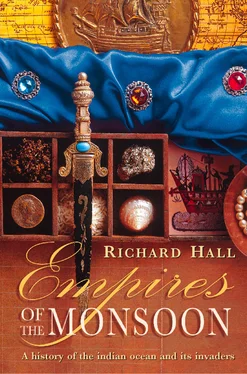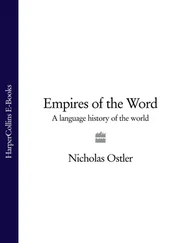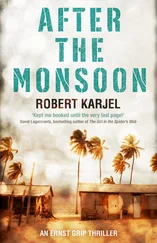In the valley below were many enclosures, probably occupied by the king’s wives and powerful retainers. The walls of the biggest were six times the height of a man and had drainage channels from the interior floor levels. To make them, a million pieces of dressed granite had been shaped and carried to the site. Inside were circular thatched houses built in the typical African style, with walls of daga , a cement-like earth often taken from anthills. It was customary to paint these walls with bright geometric patterns. Clustered round the enclosures were the huts of the lowly subjects and the slaves, captive survivors from raids on neighbours. The population of the capital grew to as much as 20,000.
The Zimbabwe gold trade was to set off a chain reaction far across the continent. Elephant tusks, dried salt, and iron weapons and implements were carried along forest paths from one market to the next, until they gained a maximum barter value in the more densely-populated districts. Even 1,000 miles away, north of the Zambezi watershed, copper deposits which had been neglected for 300 years were again worked intensively.
The king of Great Zimbabwe ruled a warlike people known as the Karanga. He and the subject chieftains, who lived round the plateau in less imposing settlements, held sway over an area almost the size of France. Their territories spread into what today is Botswana on one side, into Mozambique on the other, and across the Limpopo into what is now South Africa; the granite ruins are their monuments.
The growth of Great Zimbabwe had happened in total isolation from the formation of city-states at much the same time far away on the western side of Africa. The empires of Ghana, Mali and Songhay which rose and fell beside the Niger river might as well have been on another continent. They were almost as far to the north of the equator as Great Zimbabwe was to the south, and much of the 3,000 miles separating them was almost impenetrable tropical forest. Beside central Africa’s inland seas, from which the Nile takes its source east of the Ruwenzori (‘Mountains of the Moon’), lay cultures far more closely allied to Great Zimbabwe. Settlements almost on the same scale seem to have developed there concurrently, to gauge from massive earthworks and irrigation systems; but since their buildings were of wood and thatch, almost all the evidence has vanished in the intervening centuries. The people who lived in them seem, moreover, to have had no connection at all with the trade of the Indian Ocean.
However, one link is clear. In the great lakes region, as was the case 1,500 miles further south, iron-mining and smelting were central to the economy. Great Zimbabwe had grown rich from gold – there were more than 4,000 small gold-mines on the high plateau – but iron ruled the lives of ordinary people. Whereas most of the world first smelted copper, then progressed over many centuries to the making and hardening of iron, Africa took a single leap straight out of the stone age. This new ability spelled power, for wrought-iron weapons transformed the ways in which wars were fought and wild animals hunted; with iron axes men could chop down forests and with hoes dig more land to grow crops.
How iron-age technology developed in the interior of Africa, whether invented independently or acquired from outside, is much debated. It seems to have been used there at least as early as in Egypt or much of Europe. The first known iron-makers in sub-Saharan Africa lived to the west of what is now called Lake Victoria, just below the equator. Others were settled amid the hills of Rwanda and Burundi, in a fastness of extinct volcanoes capped with snow, of deep lakes and heavily-forested hills rich in red, haematite ore. The first traces of smelting in that remote region may date back to 1000 B.C. 5
The identity of the smelters remains a mystery. They certainly did not come from among the bushman or pygmy communities, the ‘hunting and gathering’ aborigines, since they kept humpbacked zebu cattle (an Asiatic breed) and knew how to grow simple crops. Each clay iron furnace was small but elaborate, with access points all round the base for hand-worked bellows to drive up the heat of the charcoal fire. Swathes of primeval forest were brought down to keep the furnaces fed with hardwood, because the demand for iron tools was unending. It was a pattern which would be repeated in many parts of Africa.
The mastery of smelting may have spread southwards from the Nile valley, from the Nubian city of Meroë, mentioned by the Greek historian Herodotus in 450 B.C. On the outskirts of Meroë are huge mounds of iron-slag – the city has been called the ‘Birmingham of ancient Africa’. However, the earliest evidence of iron at Meroë is dated at about 500 B.C. Another possibility is that the pioneer iron-workers may have migrated to Rwanda and Burundi from the Red Sea, herding their cattle for as much as 2,000 miles until they halted in the fertile heart of the continent. Iron-hardening methods had been ‘discovered’ in Assyria in about 2000 B.C., and the secret spread southwards from there to Arabia.
Once the skill was established at the equator, it advanced steadily southwards along the rocky backbone of Africa. By A.D. 300 iron was being smelted almost at the Cape. In some areas, the remains of hundreds of furnaces are discernible, proving the existence of highly-organized village industries. Iron hoes, like cattle, could be used to buy a bride. The metal-workers formed themselves into guilds, being regarded as men apart. It was the rule that they must practise sexual abstinence before the ores were smelted, and goats were sacrificed when a deposit was discovered. The spirit of the clay furnaces was always female; some were built with protuberances on the outside representing breasts.
At Great Zimbabwe, teams of metal-workers were constantly at their tasks. Those not making iron tools or spears were busy casting the capital’s distinctive H-shaped copper ingots, which served as a form of currency. Smoke from many furnaces hung in the air. Like most other daily activities, smelting was closely concerned with magic. It could well be imagined that restless spirits had been active inside the furnace if the metal proved impure. Rituals must be performed to set them at peace.
The king and his close advisers took divine guidance on such matters at their religious shrines in the acropolis, where the spirits of royal ancestors were worshipped. 6The time of the new moon was most auspicious. The senior sister of the king played a main role, for like the king she was regarded as being in direct contact with the ancestors. At Great Zimbabwe the shrines were adorned with green soapstone carvings of mysterious creatures, part bird, part beast, adorned with beads and tautly stylized. Since each is different they may represent the spirits of former kings. These carvings were set on tall monoliths round the shrines and below one of the birds a lifelike crocodile crawls up the pillar. The beaks of the birds are like those of eagles: in Karanga belief, the eagle carries messages between the earth and Murenga, the deity.
Other artistic remnants of the religious rituals are contorted sculptures of men and women, made in soapstone brought from a hundred miles away. The stone was also carved to form circular bowls, twenty inches across, with hieroglyphic-like designs of animals, such as zebra, baboons and dogs, on their vertical sides.
The stone-working skills of the Great Zimbabwean craftsmen, and their ability to make ornaments in gold and copper, had grown out of the traditions of wood-carving and moulding in terracotta. Wooden artefacts have been lost to time and the African climate, but proof of the depth of artistic tradition in southern Africa is to be found in the fired earthenware sculptures discovered on the edge of South Africa’s Drakensberg mountains. Made in or before A.D. 600, what are called the ‘Lydenberg Heads’ were elaborately moulded masks, big enough to be worn completely over the head. The biggest is fifteen inches tall and still bears traces of painted decoration on the terracotta. These heads, dating to at least seven centuries before Great Zimbabwe’s maturity, show an aesthetic sophistication which must have even earlier roots.
Читать дальше












